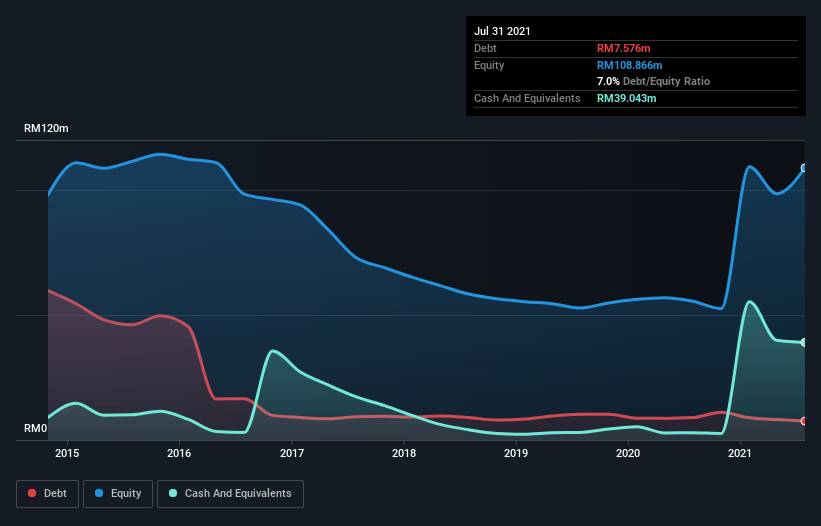- Malaysia
- /
- Commercial Services
- /
- KLSE:KOMARK
Does Komarkcorp Berhad (KLSE:KOMARK) Have A Healthy Balance Sheet?
Legendary fund manager Li Lu (who Charlie Munger backed) once said, 'The biggest investment risk is not the volatility of prices, but whether you will suffer a permanent loss of capital.' So it seems the smart money knows that debt - which is usually involved in bankruptcies - is a very important factor, when you assess how risky a company is. Importantly, Komarkcorp Berhad (KLSE:KOMARK) does carry debt. But the real question is whether this debt is making the company risky.
When Is Debt Dangerous?
Debt is a tool to help businesses grow, but if a business is incapable of paying off its lenders, then it exists at their mercy. Ultimately, if the company can't fulfill its legal obligations to repay debt, shareholders could walk away with nothing. However, a more common (but still painful) scenario is that it has to raise new equity capital at a low price, thus permanently diluting shareholders. Having said that, the most common situation is where a company manages its debt reasonably well - and to its own advantage. The first thing to do when considering how much debt a business uses is to look at its cash and debt together.
View our latest analysis for Komarkcorp Berhad
What Is Komarkcorp Berhad's Net Debt?
You can click the graphic below for the historical numbers, but it shows that Komarkcorp Berhad had RM7.58m of debt in July 2021, down from RM8.97m, one year before. But it also has RM39.0m in cash to offset that, meaning it has RM31.5m net cash.

How Healthy Is Komarkcorp Berhad's Balance Sheet?
The latest balance sheet data shows that Komarkcorp Berhad had liabilities of RM22.3m due within a year, and liabilities of RM8.40m falling due after that. Offsetting this, it had RM39.0m in cash and RM19.2m in receivables that were due within 12 months. So it actually has RM27.5m more liquid assets than total liabilities.
This excess liquidity is a great indication that Komarkcorp Berhad's balance sheet is almost as strong as Fort Knox. Having regard to this fact, we think its balance sheet is as strong as an ox. Simply put, the fact that Komarkcorp Berhad has more cash than debt is arguably a good indication that it can manage its debt safely. The balance sheet is clearly the area to focus on when you are analysing debt. But you can't view debt in total isolation; since Komarkcorp Berhad will need earnings to service that debt. So if you're keen to discover more about its earnings, it might be worth checking out this graph of its long term earnings trend.
In the last year Komarkcorp Berhad wasn't profitable at an EBIT level, but managed to grow its revenue by 11%, to RM42m. That rate of growth is a bit slow for our taste, but it takes all types to make a world.
So How Risky Is Komarkcorp Berhad?
Statistically speaking companies that lose money are riskier than those that make money. And we do note that Komarkcorp Berhad had an earnings before interest and tax (EBIT) loss, over the last year. Indeed, in that time it burnt through RM30m of cash and made a loss of RM16m. Given it only has net cash of RM31.5m, the company may need to raise more capital if it doesn't reach break-even soon. Even though its balance sheet seems sufficiently liquid, debt always makes us a little nervous if a company doesn't produce free cash flow regularly. When analysing debt levels, the balance sheet is the obvious place to start. However, not all investment risk resides within the balance sheet - far from it. For instance, we've identified 4 warning signs for Komarkcorp Berhad (2 are concerning) you should be aware of.
If you're interested in investing in businesses that can grow profits without the burden of debt, then check out this free list of growing businesses that have net cash on the balance sheet.
Valuation is complex, but we're here to simplify it.
Discover if Komarkcorp Berhad might be undervalued or overvalued with our detailed analysis, featuring fair value estimates, potential risks, dividends, insider trades, and its financial condition.
Access Free AnalysisThis article by Simply Wall St is general in nature. We provide commentary based on historical data and analyst forecasts only using an unbiased methodology and our articles are not intended to be financial advice. It does not constitute a recommendation to buy or sell any stock, and does not take account of your objectives, or your financial situation. We aim to bring you long-term focused analysis driven by fundamental data. Note that our analysis may not factor in the latest price-sensitive company announcements or qualitative material. Simply Wall St has no position in any stocks mentioned.
Have feedback on this article? Concerned about the content? Get in touch with us directly. Alternatively, email editorial-team (at) simplywallst.com.
About KLSE:KOMARK
Komarkcorp Berhad
An investment holding company, manufactures and sells self-adhesive label solutions in Malaysia, Singapore, Indonesia, the Philippines, and Thailand.
Excellent balance sheet with slight risk.
Market Insights
Community Narratives




